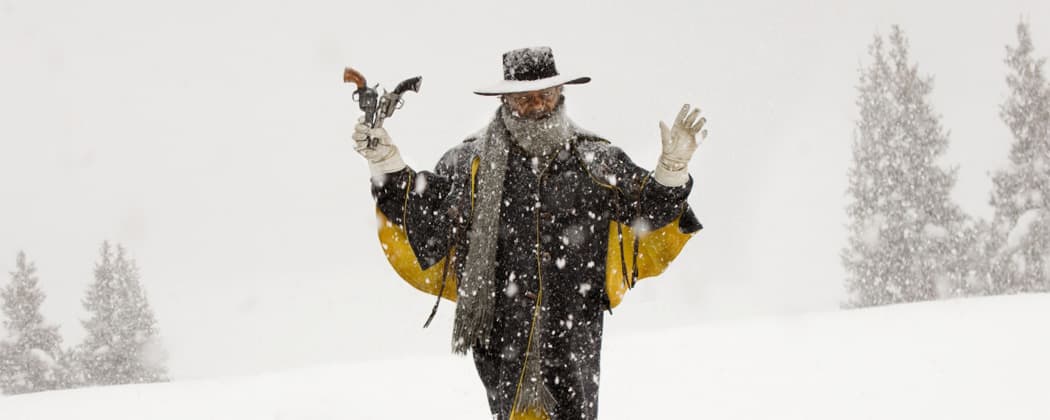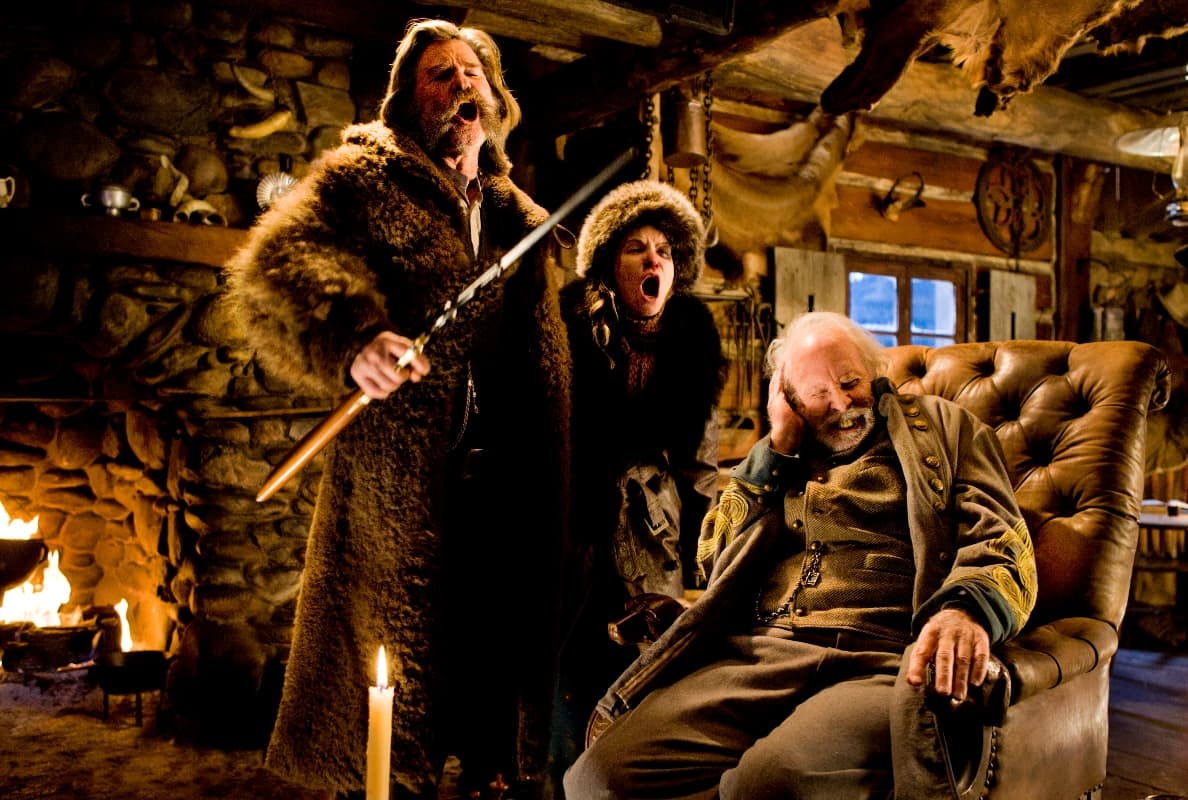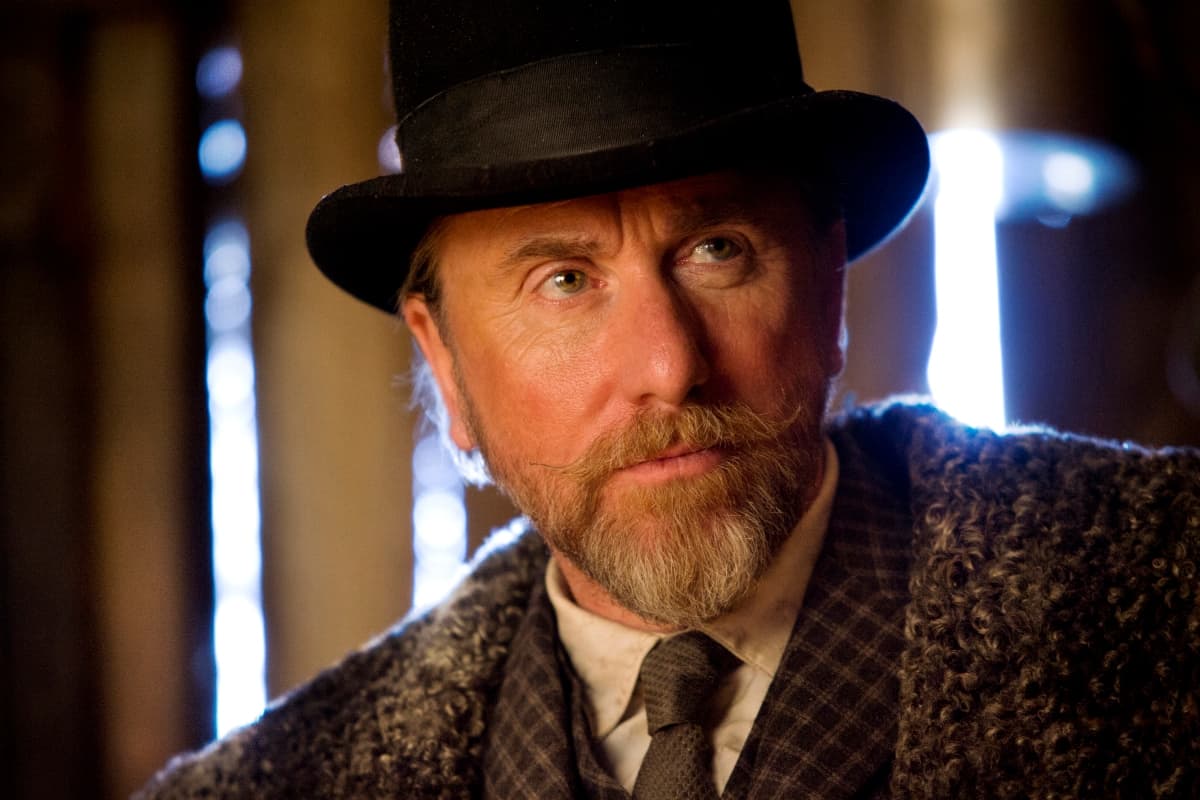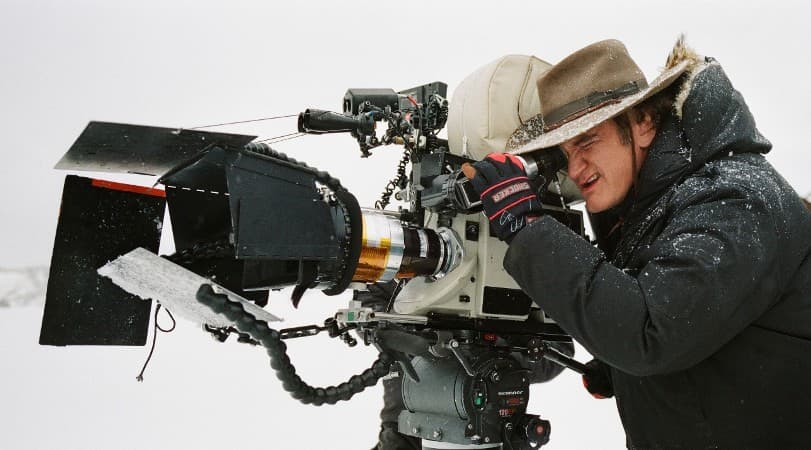Advertisement
Tarantino Is True To Form In 'The Hateful Eight,' Even If It's A Lesser Cut

"The Hateful Eight" was shelved once because Quentin Tarantino was furious that an early version of the script had been leaked. Given that the film holds the kinds of reveals and unexpected twists of an Agatha Christie whodunnit, the much ado about plot exposure holds water. But having sat through the 168 minute amble (complete with an overture and an intermission) which pretty much unfolds in a single cramped setting, one can only wonder if that earlier pass might not have been more lean and to the point.
What's ultimately served up is Tarantino channeling Tarantino with men of swagger caught in a mean situation waxing about righteousness and the universe in pulpy poetic verse as tensions rise. It's what you'd expect and hope for in a Tarantino film, but by the edgy auteur's barometer (he's helmed eight movies to date), it's a lesser cut.
What holds "Eight" in check mostly is its overindulgence, lack of nuance and the fact Q.T. has been to every corner of this room before — and I don't mean "Four Rooms." From "Kill Bill, Volume I" onward, Tarantino's been busy reshaping the revenge flick while paying homage to the quirky genres of the ‘70s, namely the cheesy b-roll ("Kill Bill" and "Grindhouse"), the Spaghetti Western ("Django Unchained") and the chopsocky silliness of kung fu flicks re-cut with lethal seriousness for the "Kill Bill" series.
"Eight" mostly distills down to "Reservoir Dogs," if redressed as "Django Unchained." It's a Western to be sure that begins on a snowy mountain pass in northern Wyoming as a coach makes a bead for shelter before the mother of all blizzards sweeps through. On board, under furs and a wide handlebar mustache, looms gruff bounty hunter John "The Hangman" Ruth (Kurt Russell aping somewhere between John Wayne and Sam Elliott) shackled wrist-to-wrist to his collared charge Daisy Domergue (Jennifer Jason Leigh who's nothing short of excellent), a foul-mouthed and resilient woman able to take a punch to the face and respond with venomous sass.

They're en route to Red Rock and the gallows but amass two others: Major Marquis Warren (Samuel L. Jackson), a fellow bounty hunter with three stiffs he's looking to collect on, and Chris Mannix (Walton Goggins, bug-eyed and in the endearingly effusive mold of Bill Paxton), the newly appointed sheriff of the town of destination. Problem is we're in the nascent postbellum period, and Mannix harbors strong rebel sentiment (and resentment), which clearly doesn't jive well with Warren's sense of being. But there is that Lincoln letter (as in penned personally by Abe himself) the major keeps fondly in his breast pocket that has a quelling and conversation-changing effect whenever he whips it out.
That's four and when they get to Minnie's Haberdashery (a makeshift general store/cantina), there's four more, Bruce Dern's cantankerous former Confederate general, Bob "The Mexican" (Demián Bichir) running the place while Minnie's away, the hangman also on way to Red Rock to perform services (Tim Roth channeling both fop and psychopath effortlessly) and a diary-penning gunslinger in black (Michael Madsen).
Advertisement

Yes, this is a Tarantino alumni gathering of sorts, but Q.T.'s not the best at math. Also taking shelter in the snow-encased haberdashery is the service-oriented coach driver (James Parks) — which makes nine if you needed to ask. Numbers aside, the coffee's bad, the front door gets ripped open by the wind and lingering tensions between North and South, and the N-word swirl up quicker than the door can be nailed shut.
More so here than in "Inglourious Basterds" or "Django Unchained," Tarantino takes a long, slow time with having Warren even the score with those from the slave-loving South. The ever affable Jackson gets to chew on some juicy diatribes (not "Pulp Fiction" good, but in the ballpark) as racial tensions reach the breaking point, however, the flashback to a scene of forced fellatio on a beaten man is a bit hard to swallow as it lacks the director's usual care and nuance. One can only assume that after "Basterds" and "Django," Tarantino's sense of social championing has gone to his head and become over fermented. Still, at the heart of "Eight" beats a mole amidst the snowbound lot, echoing the similar subterfuge plot that propelled "Reservoir Dogs," and it holds the film tight until the first body falls.
Besides the wayward script, Tarantino, as part of his obsessive adoration of filmmaking past, filmed on 70 mm (65 mm with a Panavsion 70 mm lens — something that hasn't been widely used since the early ‘70s) and mandated its display on 70 mm projection. The big pause there is that there are only about 200 able projectors left, to garner which Tarantino and The Weinstein Company partnered with Boston Light & Sound and the various theaters to stage 100 capable screens nationally — including three here in Boston. It's a bold move that's likely to rekindle the debate about the aesthetic value of digital as an adequate replacement for film.

The 70 mm version runs slightly longer than the digital print I saw. No matter, in the tight rustic quarters of the haberdashery or out in the vast snow white, Robert Richardson's cinematography frames the action in texturally deep artistic layers. The layup here, one would think, is the score by the legendary composer Ennio Morricone who so brilliantly provided the soul and rhythm of Sergio Leone's classic Westerns. There are times when the mood and beat are awkwardly out of sync, but when there’s synergy and harmony, it elevates the collective effort with poetic purpose and resonance.
Leading up to the release of "The Hateful Eight," Tarantino has made numerous rumblings about hanging up his director's cap after 10 films. He's got eight in the oat bag (the film's title clearly coming with a nod and a wink ) to date. If he holds true to that (and it's been purported that "Eight" is the first of three Westerns), I'm still going to hold out hope for a sequel (or prequel) to "Pulp Fiction" or "Jackie Brown." After all, what better way for a filmmaker, whose films have been fresh revisionist love letters to the classics, to go out than to revise one of his own modern classics?
Tom Meek is a writer living in Cambridge. His reviews, essays, short stories and articles have appeared in The Boston Phoenix, Paste Magazine, The Rumpus, Thieves Jargon, Charleston City Paper and SLAB literary journal. Tom is also a member of the Boston Society of Film Critics and rides his bike everywhere. You can follow Tom on Twitter at @TBMeek3 and read more at TBMeek3.wordpress.com.
